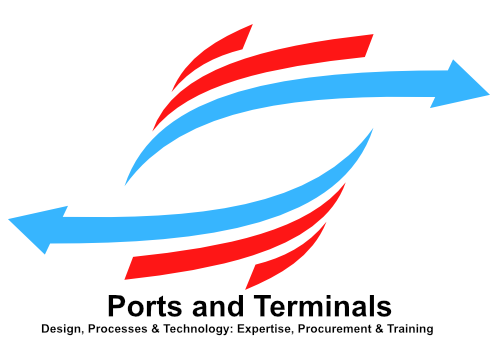The terms “port” and “terminal” are often used as common words to refer to a location where cargo and vessels are handled. However, for clarity, we are talking in this article about commercial ports handling cargo and do not refer to fishing ports, ferry ports or marinas.
To better understand what the words “port” and “terminal” mean, we should start with what they do and what services they provide. Since ports can be classified in various types, the easiest is to start defining what a terminal is. I’ll elaborate in a separate post on the types and roles of ports and how they are classified. However, we’ll stick here to the basics when defining the meaning of the concept “port”.
What is a terminal?
A terminal is a facility where cargo is handled. Remember we are focusing on cargo in our definition. Let us further assume we are talking about marine terminals and facilities capable of receiving ocean-going vessels. Cargo handling then means discharging cargo from these vessels or loading cargo on the vessels. Another word for loading and discharging is “stevedoring”. The word stevedoring is de- rived from the Spanish word “Estibador”. An “estibador” is a person who loads or discharges a ship.
After discharging cargo from the ship, machines usually transport the cargo to a storage area. The cargo remains there until another means of transport – a truck, a train, a barge – comes to collect the cargo for the onward transport to the consignee, the importer of the goods. I just described the import cycle: from the vessel to the hinterland.
Looking at the export cycle, the sequence is the other way around. First, goods travel from the producer or exporter by truck, train or barge to the terminal, where they stay until they are loaded on a vessel, sailing the ocean to the Port of Discharge, the POD.
What types of terminals exist?
The cargo, or the commodity type, handled at the terminals classifies the terminal or determines its type. The following list contains an overview of the most common commodity types:
- Containers
- General Cargo
- Dry Bulk
- Liquids
- RoRo cargo
- Cars/Vehicles
- Project Cargo
Based on this list, we can make a classification of the terminals. Some terminals may handle multiple types of commodities and are called mixed or multi-commodity terminals. Typically, General Cargo will also handle Project Cargo.
Often Car terminals are also called RoRo terminals. However, I prefer to call terminal handling cars a car terminal and not a RoRo terminal because RoRo and Cars are not the same. The processes on the terminal are different, and the types of vessels are different. In my book, Roro refers to cargo on wheels like on a Mafi, trailers (with or without tractor), and heavy machinery on wheels (self-propelled or towed/ pushed).
We’ll discuss the types in more detail in a separate post and clarify how processes work on these terminals, what differences we can identify and where we can observe similarities.
What is a port?
As Wikipedia says, the most straightforward definition for a marine port is, “A port is a maritime facility comprising one or more wharves or loading areas, where ships load and discharge cargo and passengers. From <https://en.wikipedia.org/wiki/Port>
Since we focus on cargo handling, we can leave out the concept of “passengers”. Wikipedia talks about wharves, while we call them terminals, which is a more widely accepted concept in the above definition.
The definition says a port is a maritime facility, but it can also be located in-land and connected to the sea by a river or canal. Some examples: Antwerp, Ham- burg. The port provides vessels access to the terminals’ cargo handling facilities as a maritime facility.
The Wikipedia definition leaves out an essential element: the connection to the hinterland. The rail or road network connecting the port to the consumers, the im- porters, producers, and exporters is crucial. At least in a gateway port. How else would cargo get from the port/terminal to the hinterland? A gateway port is a hub in the export and the import cycle. On the other hand, for a transhipment port, the cargo connections to the hinterland are less important.
A port is, in general, managed by what is called a Port Authority. The port manager could be a public, a private or a mixed entity and may provide services to vessels or any other stakeholder doing business with the port.
Earlier, we mentioned already that there are several types of ports. Some types may also act as terminals, meaning that they are involved in cargo handling. When considering a landlord port type, the port authority is not involved in handling cargo. For the service port, cargo handling or stevedoring is a core activity.
Conclusion: what is the difference between a port and a terminal?
The core activity of a terminal is stevedoring or cargo handling. There may be several terminals operating in a port, classified by the type of commodity they process. Unless it is a service port, a port is usually not involved in cargo handling. Instead, a port provides services to the terminal operators, grants a concession, and enables and maintains marine and land access. A port or, better, port authority may be a regulator and may provide marketing services for the whole of the port community. In addition, port authorities may provide services to vessels.
As you understand, there are a few conditional statements in the conclusion. These conditional statements apply specifically to ports or port authorities. I’ll get into more details when discussing the various port models.
© 2022, [Nico Berx], all rights reserved. The content of this article is protected by copyright and may not be reproduced in any form without prior and explicit approval by the author.

